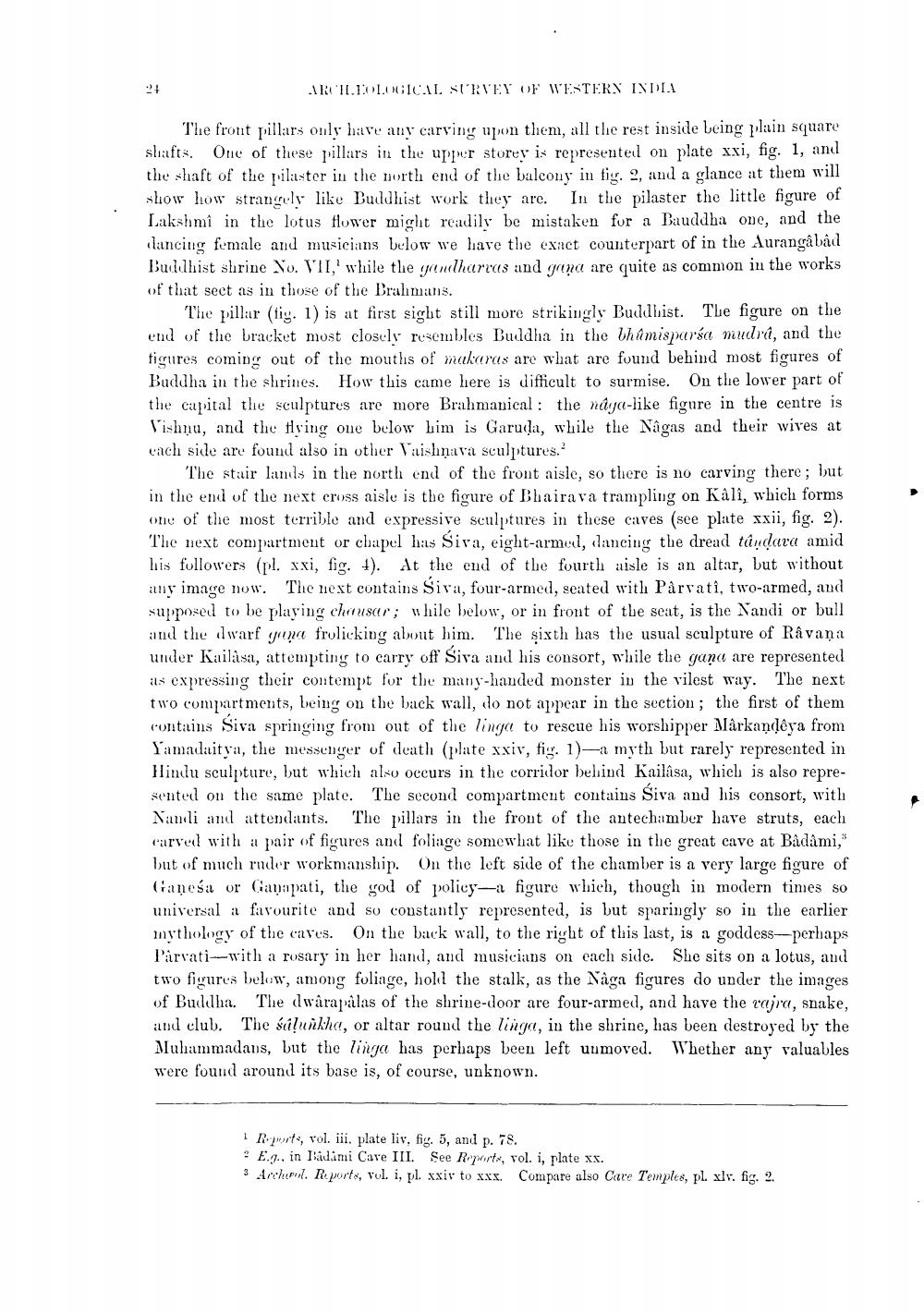________________
24
ARCH.EOLOGICAL SURVEY OF WESTERN INDIA
The front pillars only have any carving upon them, all the rest inside being plain square shafts. One of these pillars in the upper storey is represented on plate xxi, fig. 1, and the shaft of the pilaster in the north end of the balcony in fig. 2, and a glance at them will show how strangely like Buddhist work they are. In the pilaster the little figure of Lakshmi in the lotus flower might readily be mistaken for a Bauddha one, and the dancing female and musicians below we have the exact counterpart of in the Aurangabad Buddhist shrine No. VII,' while the gandharvas and gana are quite as common in the works of that sect as in those of the Brahmans.
The pillur (fig. 1) is at first sight still more strikingly Buddhist. The figure on the end of the bracket most closely resembles Buddha in the bhamisparsa madre, and the figures coming out of the mouths of makaras are what are found behind most figures of Buddha in the shrines. How this came here is difficult to surmise. On the lower part of the capital the sculptures are more Brahmanical: the naya-like figure in the centre is Vishnu, and the flying one below him is Garuda, while the Nagas and their wives at each side are found also in other Vaishnava sculptures
The stair lands in the north end of the front aisle, so there is no carving there; but in the end of the next cross aisle is the figure of Bhairava trampling on Kâlî, which forms one of the most terrible and expressive sculptures in these caves (see plate xxii, fig. 2). The next compartment or chapel has Siva, eight-armed, dancing the dread taedava amid his followers (pl. xxi, fig. 4). At the end of the fourth aisle is an altar, but without any image now. The next contains Siva, four-armed, seated with Parvati, two-armed, and supposed to be playing chousur; while below, or in front of the seat, is the Nandi or bull and the dwarf ge frolicking about him. The sixth has the usual sculpture of Ravana under Kailasa, attempting to carry off Siva and his consort, while the guna are represented as expressing their contempt for the many-handed monster in the vilest way. The next two compartments, being on the buck wall, do not appear in the section; the first of them Contains Siva springing from out of the linge to rescue his worshipper Märkandeya from Yamadaitya, the messenger of death (plate xxiv, fig. 1)-a myth but rarely represented in Hindu sculpture, but which also occurs in the corridor behind Kailasa, which is also represented on the same plate. The second compartment contains Śiva and his consort, with Nandi and attendants. The pillars in the front of the antechamber have struts, each carved with a pair of figures and foliage somewhat like those in the great cave at Badami," but of much ruder workmanship. On the left side of the chamber is a very large figure of Ganesa or Ganapati, the god of policy-a figure which, though in modern times so universal a favourite and so constantly represented, is but sparingly so in the earlier mythology of the caves. On the back wall, to the right of this last, is a goddess-perhaps Pârvati-with a rosary in her hand, and musicians on each side. She sits on a lotus, and two figures below, among foliage, holl the stalk, as the Någa figures do under the images of Buddha. The dwarapalas of the shrine-door are four-armed, and have the rojo, snake, and club. The silunkhe, or altar round the linge, in the shrine, has been destroyed by the Muhammadans, but the linga has perhaps been left unmoved. Whether any valuables. were found around its base is, of course, unknown.
1 Reports, vol. iii. plate liv, fig. 5, and p. 78.
2E... in Badami Cave III. 3 Archirol. Reports, vol. i, pl.
See Reports, vol. i, plate xx.
xxiv to xxx. Compare also Care Temples, pl. xlv. fig. 2.




